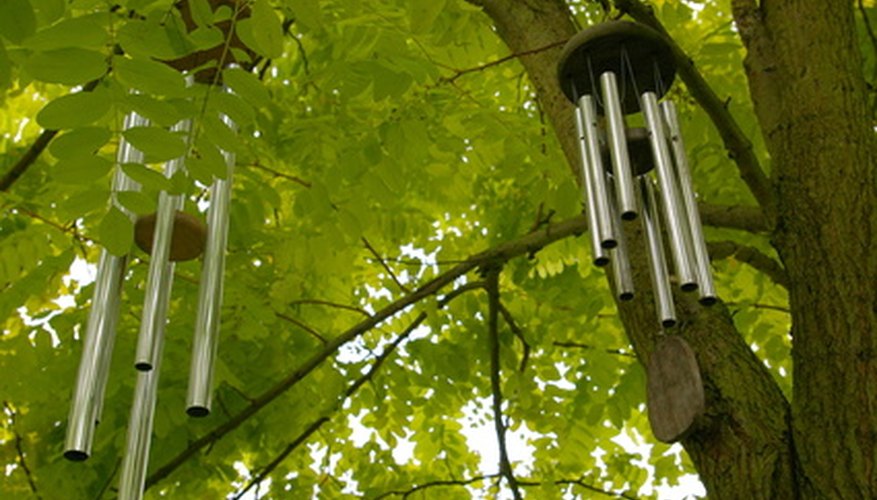Wind chimes can add music and visual interest to your backyard retreat. Making your own wind chimes is a relatively simple task that begins with calculating the appropriate length of pipe for each desired note. Many wind chimes use the pentatonic, or five-note, scale that is used in rock, jazz, blues, country and bluegrass music. The benefit of using a pentatonic scale, versus another major or minor scale, is that there is no displeasing combination of pentatonic notes.
- Wind chimes can add music and visual interest to your backyard retreat.
- Making your own wind chimes is a relatively simple task that begins with calculating the appropriate length of pipe for each desired note.
Cut one pipe to a length that creates a note that sounds good to you. To create a true major or minor pentatonic scale, match your note to a D sharp or F sharp on the piano. You do not have to use these notes as starting points. You may start with any note. This will become the reference point for the remaining notes on your scale.
Figure out the remaining pipe lengths using this formula: 1/(frequency)1/2. This means length is proportional to the inverse of the square root of the frequency.
- Plug in your original pipe length and the major or minor frequency ratios into the formula in Step 2.
- You can still create a pentatonic scale by plugging in your original pipe length and either the major or minor frequency ratios into the formula.
- (
Create either a major or a minor pentatonic scale. You can compare the two scales by playing only black keys on the piano. For the minor pentatonic scale, begin with D sharp, then play the next four notes. For the major pentatonic scale, start with F sharp.
Use the following frequency ratios. On the major pentatonic scale, the second note has a 9/8 frequency ratio (1.125), the third note has a 5/4 frequency ratio (1.25), the fourth note has a 3/2 frequency ratio (1.5), and the fifth note has a 5/3 frequency ratio (1.6667). To create a note an octave higher than your first note, plug in a frequency ratio of 2. The frequency ratios of the minor pentatonic scale are 6/5 (1.2), 4/3 (1.333), 3/2 (1.5) and 9/5 (1.8).
- Plug in your original pipe length and the major or minor frequency ratios into the formula in Step 2.
- You can still create a pentatonic scale by plugging in your original pipe length and either the major or minor frequency ratios into the formula.
- (
- Figure out the remaining pipe lengths using this formula: 1/(frequency)1/2.
- On the major pentatonic scale, the second note has a 9/8 frequency ratio (1.125), the third note has a 5/4 frequency ratio (1.25), the fourth note has a 3/2 frequency ratio (1.5), and the fifth note has a 5/3 frequency ratio (1.6667).
Plug in your original pipe length and the major or minor frequency ratios into the formula in Step 2. This will give you the lengths of your remaining pipes. If your first pipe is 30cm, for example, the third note on your major pentatonic scale would equal 30/(1.25)1/2 or 26.8cm. It doesn't matter if you did not cut your first pipe length to create a D-sharp or F-sharp note. You can still create a pentatonic scale by plugging in your original pipe length and either the major or minor frequency ratios into the formula. (Reference 4)
- Plug in your original pipe length and the major or minor frequency ratios into the formula in Step 2.
- You can still create a pentatonic scale by plugging in your original pipe length and either the major or minor frequency ratios into the formula.
- (
Adjust the sound of your wind chime by cutting down the pipes or adding new pipes of different lengths.
TIP
Use pipes with uniform thickness for the best sound. (Reference 2) Soft metals such as copper will generate softer tones. Harder metals like steel and aluminium will generate sharper tones. (Reference 3) If you want to avoid the math, you can cut the pipes by trial and error using your ear and a keyboard. (Reference 3)
